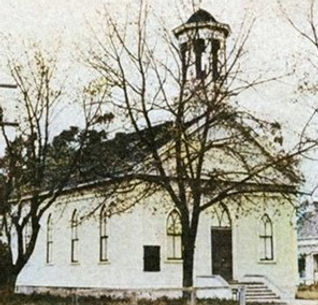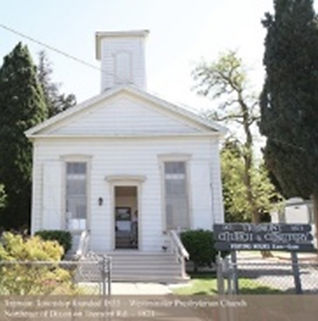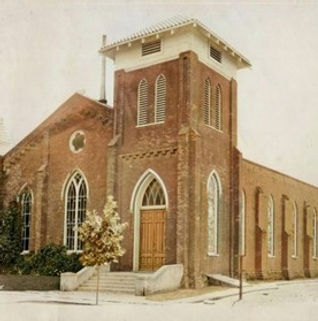Churches

Silveyville Township Founded 1852 - Methodist Church founded in Silveyville -1858
Rolled into Dixon in 1870 - Now located at Jefferson and West B Streets.
The first European settlement in the Dixon area was established in 1852 by Elijah S. Silvey, 3.5 miles west of Dixon today at Silveyville and Schroeder Roads. In 1852, in addition to farming the land, Silvey opened a hotel and saloon called the Halfway House, which was located along a route between the Bay Area and the Sierra gold mines. The Halfway House was a hotel made famous by prospectors and miners traveling on foot or by horse. At night, Silvey would place a red lantern high up on a pole to aid travelers in finding his hotel. The gold rush ended in 1855, and later between 1857-1861 the Halfway House became a stop between the Bay Area and Sacramento for passengers traveling by Stagecoach. By 1865, the community of Silveyville had a general store, post office, blacksmith, two churches, a school, and a population of 150 people. The process of moving Silveyville to its new location involved raising homes and businesses onto round logs. Teams of horses and mules pulled the buildings forward. When a building had rolled past a log, men would carry the log to the front of the building and the horses and mules would continue pulling. One of the first buildings that still stands in Dixon from this move is the Dixon United Methodist Church at 209 Jefferson Street (moved in 1870). Residents from the Tremont and Maine Prairie townships also moved from their respective townships to be closer to the railroad.

Tremont Township founded in 1855 – Westminster Presbyterian Church – Northeast of Dixon on Tremont Rd. - 1871
The Tremont township, located on Tremont Road between what is today Davis and Dixon, was established in 1855. Prior to 1848, the land in the area now known as Tremont was owned by some of the land grant families, such as Wolfskill and Vaca. Many of Tremont´s later settlers originated from Germany. A large warehouse there was a shipping center for grain growers for many years. In 1870, Tremont had a population of 640. Today, a church, dedicated in 1871 by a group of women called the Tremont Mite Society, with Sunday service lasting until 1920s, remains with an adjoining cemetery where many of the founding families are buried.

First Baptist Church – South First St. between West A and West Mayes Streets - 1877
The Dixon Community Church was formally constituted on October 26, 1856, in Pleasant Retreat schoolhouse on Ulatis Creek, between present-day Elmira and Vacaville, and was named, Vaca Valley Baptist Church. The church´s location changed several times. In 1859 they met for one year in the Pitt Schoolhouse on Pitt School Road, and then moved to Silveyville in 1860. In 1873 they moved to the new town of Dixon, founded in 1868 with the building of the railroad. In 1877, the prospering congregation erected the First Baptist Church on South First Street (near West Mayes St.) for $12,000. It survived the Great Fire of 1883. The pointed spire was removed after the earthquake of 1892. But by 1965, crumbling bricks and a leaking roof, not to mention a growing congregation, made a move necessary. When this building was torn down, eight of the beautiful stained-glass windows (a part of the church since early 1900s) were carefully removed, saved, and replaced, as the new windows for the Dixon Community Church that was completed and dedicated in 1967, and is located to this day on East A Street. The church family was strictly Baptist until 1917 when some Presbyterians, and a few from other denominations, chose to join. Later, the church became the United Protestant Church until 1939 when the members of the German Lutheran Church decided to combine with this church. In 1940, the church became the Dixon Community Church, with a congregation of many denominational backgrounds, all seeking to grow as Christians through the love of Christ.

Second St. Peter’s Catholic Church – South Second St. and East A St. - 1915
In 1868, a wooden sanctuary, built as a mission took its name from Saint Peter, the revered leader of the 12 Apostles. The mission found its place on Second Street, between East A and East Mayes Streets, right where the modern-day parking lot now sits. Dixon itself was part of the greater Suisun mission network, with priests traversing vast distances between communities on horseback, often following trails and ancient paths created by native peoples. In 1877, a significant milestone was reached at St. Peter’s Church attained parish status. As the years passed, the original wooden structure, once the pride of the parish, could no longer accommodate the growing congregation. A new era was dawning for St. Peter’s. At the opposite end of the block, the foundation for the present church was laid in 1915. Construction commenced, and in 1916, the magnificent edifice we now know at St. Peter’s Church was unveiled to the community, an architectural marvel that cost approximately $25,000 to build. The foundation stone, bearing the year 1915, still stands as a testament to this historic endeavor, greeting all who enter. The interior altar mural was painted by Colleen Gnos.
Today, St. Peter’s Church continues to thrive as a spiritual beacon in Dixon with six weekend Masses serving the diverse needs of our community – three in English and three in Spanish. Next to the Catholic Church, on the corner of South 2nd and East Mayes Streets was the L. Newby House that was built in 1860 in Silveyville and rolled into Dixon in 1895. Many historical homes are located on East Mayes Street and belonged to the following families: Cowden, Schmeiser, Mace, Rossi, Hall, Moss, McKenzie, Castner, Rohwer, McLaughlin, Tutt, Runge, Brazil and Torchia. On East Mayes there are two carriage steps that were used to help passengers easily step in and out of their carriages. Three other carriage steps remain in Dixon on the following streets: South 1st, West A (Frosty’s) and East A Streets.

